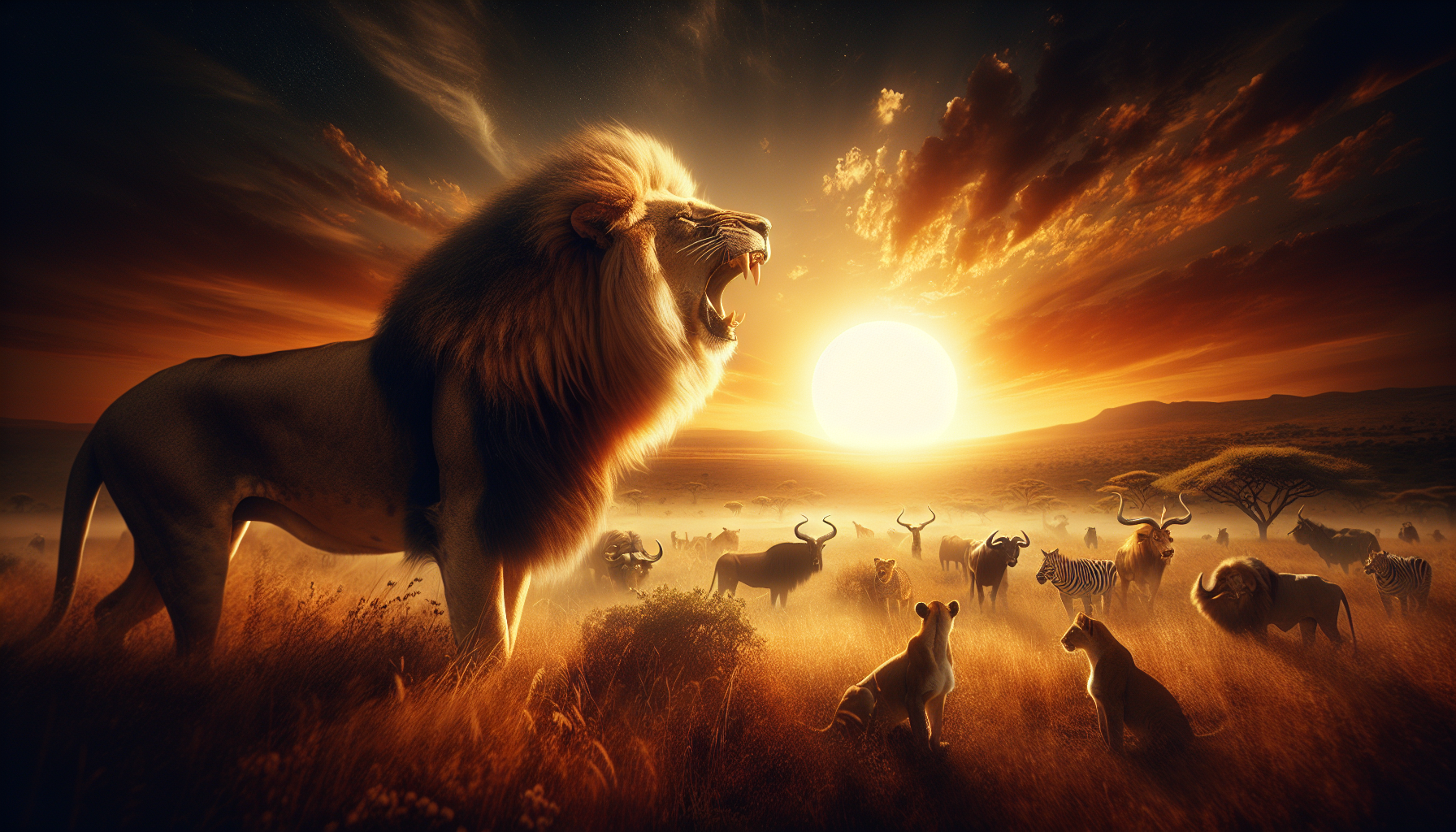In the heart of the vast African savannah, where the golden grasses ripple like an ocean under the relentless sun, there exists a creature whose very presence commands awe and respect. The lion, often hailed as the “King of the Jungle,” carries with it a legacy steeped in majesty and mystery. Its roar is not just a sound but a symphony of power that echoes through the wilderness, embodying the spirit of the wild. This majestic beast has roamed the African plains for millennia, weaving its way into the fabric of countless cultures and legends. Today, we embark on a mythical journey, exploring the enduring power of the lion’s roar and its profound significance in African folklore. 🌍🦁
The lion’s roar is more than a mere call; it is a resonant anthem of dominance, a declaration of sovereignty over its territory. Reverberating up to five miles across the savannah, this mighty sound serves both as a warning to rivals and a call to the pride. Yet, beyond its practical implications in the animal kingdom, the lion’s roar has permeated the cultural and spiritual narratives of African societies. In many tribes, the lion is revered as a symbol of strength, courage, and leadership. Its roar is believed to possess the power to ward off evil spirits and bring protection and prosperity to those who honor it. This deep-seated reverence is reflected in a rich tapestry of myths and stories passed down through generations, each narrating tales of bravery, wisdom, and the unbreakable bond between man and nature.
As we delve deeper into the mythical landscape of Africa, we encounter a mosaic of legends where the lion takes center stage. From the savannahs of Kenya to the deserts of Namibia, the lion’s roar is a recurring motif that transcends geographic boundaries. In some tales, the lion is a divine messenger, bridging the gap between the earthly and the spiritual realms. In others, it is a formidable adversary, challenging heroes to confront their deepest fears and emerge victorious. These stories are not just relics of the past; they continue to inspire and shape the identities of the communities that cherish them. They are a testament to the timeless allure of the lion and its roar, capturing the imagination and igniting the spirit of adventure in all who hear it.
Throughout this exploration, we will unravel the intricate relationship between the lion and the land it inhabits. The lion’s roar is a symbol of the untamed beauty and raw power of the African wilderness—a call to embrace the spirit of the safari, where nature reigns supreme and every moment is infused with the thrill of discovery. By understanding the cultural and ecological significance of the lion’s roar, we gain a deeper appreciation for the delicate balance that sustains these majestic creatures and the ecosystems they call home. We will examine the conservation efforts that seek to preserve this iconic species and the challenges faced by those dedicated to ensuring its survival in an ever-changing world.
Join us as we embark on this extraordinary journey into the heart of Africa, guided by the mighty roar of the lion. Together, we will explore the myths, legends, and realities that define the lion’s place in the tapestry of life on this continent. Whether you are a seasoned traveler or a curious reader, this exploration promises to awaken your senses and deepen your connection to the wild spirit of the safari. Prepare to be captivated by the stories, inspired by the courage, and moved by the enduring power of the lion’s roar—a symbol of the indomitable spirit that resides within us all. 🌿✨
The Roar of the Lion: The Heartbeat of African Mythology
In the vast savannahs of Africa, where the golden grass sways to the rhythm of the wind and the horizon seems to stretch endlessly, the lion reigns supreme. Known as the “King of the Jungle,” the lion’s roar is a symphony that echoes across the plains, sending shivers down the spine of every creature within earshot. But beyond its physical prowess and majestic appearance, the lion holds a special place in African mythology, symbolizing power, courage, and mystery.
African folklore is rich with tales that revolve around the lion, often depicting it as a guardian of the natural world and a representation of divine authority. The lion’s roar is not just a call to the wild but a voice of the gods, an ethereal sound that bridges the earthly realm with the spiritual. Many tribes believe that hearing a lion’s roar at dawn is a sign of protection and prosperity, a blessing from the ancestors watching over them.
For centuries, the lion has been woven into the cultural tapestry of Africa, appearing in stories that teach moral lessons, uphold social norms, and instill a sense of community. Through these narratives, the lion’s roar transcends its biological function, becoming a powerful symbol of the untamed spirit of Africa itself.
Legends of the Roar: Stories that Shape Cultures
Across the African continent, countless tribes have their own unique tales involving the lion. In the Maasai culture, for instance, the lion is revered as a symbol of bravery and strength. Young Maasai warriors, or Morans, must prove their valor by facing lions, and the roar is said to be the lion’s challenge to those who dare to confront it. This ritual is not only a test of courage but a rite of passage, marking the transition from youth to adulthood.
In contrast, the San people of the Kalahari Desert tell stories where the lion embodies wisdom and justice. The roar is a judgment call, an authoritative declaration that settles disputes and restores harmony among the creatures of the wild. According to San folklore, when animals hear the lion’s roar, they are reminded of their place in the natural order and the importance of living in balance with their surroundings.
These stories highlight the diverse ways in which the lion’s roar has been interpreted across cultures, each narrative adding a layer of meaning to this awe-inspiring sound. To explore more about these cultural tales, watch the video: “The Cultural Significance of Lions in Africa” – Wild Discoveries.
The Science Behind the Roar: Nature’s Masterpiece
Beyond the myths and legends, the lion’s roar is a marvel of nature, a complex vocalization that serves multiple purposes in the wild. Scientifically, a lion’s roar can reach up to 114 decibels and can be heard from as far as five miles away. This impressive range is attributed to the unique structure of the lion’s vocal cords, which are thicker and more elastic than those of other big cats.
Understanding the mechanics of a lion’s roar involves delving into the anatomy of its larynx and the surrounding muscles. The lion’s larynx is larger than that of most animals, allowing it to produce a sound that is not only loud but also deep and resonant. This powerful sound is further amplified by the lion’s chest cavity, acting as a natural amplifier that projects the roar across vast distances.
The roar serves several functions in the wild, including territory establishment, communication with pride members, and deterring potential threats. When a lion roars, it is announcing its presence to other lions, asserting dominance, and warning rivals to stay away. This vocalization is crucial for maintaining social structures within the pride and ensuring the lion’s survival in the competitive environment of the African savannah.
The Role of the Roar in Lion Social Structure
Lions are social animals that live in groups known as prides, consisting of related females, their offspring, and a small number of adult males. The dynamics within a pride are complex, and communication plays a vital role in maintaining harmony and cohesion. The roar is a key component of this communication system, enabling lions to convey messages over long distances.
Male lions, in particular, use their roar to establish dominance and attract mates. During the mating season, roaring becomes more frequent as males compete for the attention of females. The intensity and frequency of the roar can influence mating success, with more dominant males typically exhibiting stronger and more frequent vocalizations.
| Animal | Decibel Level | Hearing Range | Purpose |
|---|---|---|---|
| Lion | Up to 114 dB | Up to 5 miles | Territorial, Communication |
| Tiger | Up to 100 dB | Up to 2 miles | Territorial |
| Jaguar | Up to 80 dB | Up to 1 mile | Territorial, Mating Call |
| Leopard | Up to 70 dB | Up to 0.5 miles | Communication |
As you can see, the lion’s roar is unmatched in both volume and range, underscoring its role as a dominant force in the animal kingdom. To witness the power of a lion’s roar in the wild, check out the video: “The Science of a Lion’s Roar” – National Geographic.
The Symbolic Resonance of the Lion’s Roar in Modern Culture
While the lion’s roar has long been revered in traditional African societies, its symbolism has transcended continents, finding a place in modern popular culture around the world. Today, the lion’s roar continues to inspire and captivate, appearing in films, literature, and even as a motif in branding and advertising.
In cinema, the lion’s roar is often used to evoke a sense of majesty and power, with iconic films such as “The Lion King” bringing the sound to life for audiences of all ages. The lion’s roar in the film symbolizes the protagonist’s journey and the reclaiming of his rightful place as king, echoing the themes found in African mythology.
In literature, the lion’s roar serves as a metaphor for courage and inner strength. Authors draw upon the majesty of the lion to illustrate characters who overcome adversity, face their fears, and rise to the challenges before them. The roar becomes a narrative device, a reminder of the primal instincts that reside within all of us.
The Lion’s Roar in Branding and Media
Brands and media outlets have also harnessed the power of the lion’s roar to convey messages of dominance, authority, and reliability. From car manufacturers to sports teams, the image and sound of the lion are used to project confidence and excellence. The roar becomes an auditory logo, a sonic signature that leaves a lasting impression on consumers.
- Automotive Industry: Car brands often use the lion’s roar to symbolize performance and power.
- Sports Teams: Teams adopt the lion as a mascot to inspire fearlessness and team spirit.
- Media and Entertainment: The lion’s roar is synonymous with quality and prestige in film and television.
The continued fascination with the lion’s roar speaks to its timeless appeal and its ability to resonate with audiences across cultures and generations. Its symbolic power remains as potent today as it was in the ancient tales of Africa, a testament to the enduring legacy of the mighty lion.

Conclusion
In conclusion, the captivating journey through African legends and the power of the mighty lion roar serves as an enthralling exploration into the heart of the continent’s rich cultural tapestry. This exploration has brought to light the multifaceted symbolism of the lion within various African societies, where it stands as a beacon of strength, courage, and leadership. Through myths and stories passed down through generations, we have seen how the lion’s roar is not just a sound but a profound symbol of authority and resilience that resonates deeply with the human spirit.
Throughout this article, we delved into the mythological landscapes where the lion reigns supreme. We discovered how the lion is revered across different African cultures, often seen as a spiritual guide and protector. The tales of the lion’s bravery and wisdom offer timeless lessons about human values, teaching us about leadership, the importance of community, and the resilience needed to overcome life’s challenges. These stories serve as a reminder of the interconnectedness of all life and the respect owed to the natural world—a lesson that is increasingly vital in today’s world.
Furthermore, the article highlighted the role of the lion in ecological systems. As apex predators, lions maintain the balance within their ecosystems, ensuring biodiversity and the health of the savanna. This biological perspective complements the cultural narratives, underscoring the lion’s integral role in both the physical and spiritual realms.
In emphasizing the lion’s iconic status, we also touched upon the modern challenges facing these majestic creatures. Habitat loss, human-wildlife conflict, and poaching are threats that endanger their existence. Preserving the lion’s habitat is crucial, not only for the survival of the species but also for maintaining the cultural and ecological heritage that they represent. Conservation efforts, therefore, are not just about saving a species; they are about preserving a legacy that is central to the identity of African cultures.
By understanding and appreciating the powerful symbolism of the lion’s roar, we are invited to reflect on our own lives and the values we hold dear. The lion encourages us to embrace our own inner strength and to face our fears with courage and dignity. It inspires us to lead with integrity and to stand up for what is right, no matter the challenges we face.
As we conclude this mythical journey, let us remember the lessons from the lion’s roar and apply them in our daily lives. Let us strive to be the leaders of our own stories, to protect the vulnerable, and to respect the delicate balance of our natural world. The spirit of the lion is a call to action, urging us to be bold and fearless in the pursuit of our dreams.
We encourage you to share this article and the timeless wisdom it conveys with others. Discuss it with your friends and family, and let the stories of the lion inspire conversations about leadership, courage, and conservation. By spreading these narratives, we contribute to a broader understanding of the importance of preserving both cultural heritage and biodiversity.
Join us in celebrating the mighty lion and the profound impact it has on our lives and the world around us. Let this be a reminder of the beauty and power inherent in our natural world, a call to cherish and protect it for future generations. As we roar together with the lions, we stand united in our quest for a more harmonious and sustainable world.
🌍🦁
For more insights into the fascinating world of African legends and wildlife conservation, consider exploring resources such as the African Wildlife Foundation here, or delve into the mythological studies at the University of Pennsylvania Museum of Archaeology and Anthropology. These resources provide further reading and opportunities to engage with the topics discussed in this article.
Thank you for embarking on this journey with us. We hope it has been as enlightening and inspiring for you as it has been for us in crafting it. Together, let us unleash the power of the lion within us all.
Toni Santos is a sound storyteller and folklore researcher whose creative path bridges the mystical and the biological through the lens of bioacoustic folklore. With an ear attuned to the voices of nature, Toni explores how ancient cultures interpreted birdsong, forest echoes, and animal calls—not as noise, but as messages, omens, and myths encoded in sound.
Rooted in a passion for both natural science and ancestral lore, his work uncovers the forgotten connections between ecosystems and oral traditions. From the whispered warnings in owl cries to the songs of frogs heralding rain, Toni’s narratives evoke a time when humans listened to nature with reverence and meaning.
Drawing on a background in ecological arts and auditory storytelling, Toni merges field recordings with mythic imagery, turning natural sounds into cultural artifacts of wonder. His stories do more than entertain—they restore a way of hearing the world that blends intuition, memory, and deep listening.
As the creative force behind Vizovex, Toni offers sonic tales, symbolic soundscapes, and research-based reflections that help others rediscover the sacred language of the wild.
His work is a tribute to:
The mythological significance of animal and elemental sounds
Ancient practices of listening for meaning in nature
The spiritual dialogue between humans and soundscapes
Whether you’re a folklorist, an acoustic ecologist, or a curious listener, Toni invites you into a world where the forest speaks, and every chirp, croak, and howl carries a story—one echo, one legend, one call at a time.





